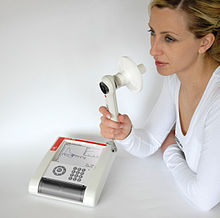Spirometer
The spirometer is a measuring instrument used in medicine to determine lung volumes and capacities. It consists of an air collection system (it can be bellows or bell) and an inscription system mounted on a support that moves at the desired speed.
The addition of a potentiometer that generates a signal proportional to the displacement of the bell allows transforming the mechanical signal into an electrical one.
Currently, almost all spirometers are capable of calculating the derivative of the measured volume to transform it into flow (V/t).
History
The first attempt to measure lung volumes dates back to the period 129-200 AD. C. when Galen, a Greek physician and philosopher, began experiments in volumetric ventilation of humans. His experiment made a child breathe in and out of a bladder, discovering that the volume that entered with each breath did not vary. Nothing more was heard of this experiment.
In 1681, Giovanni Alfonso Borelli tried to measure the volume of air inspired by a breath by drawing a column of water into a cylindrical tube and measuring the volume of air displaced by the water. In his experiment, Borelli covered his mouth. nose to prevent air from entering or leaving your lungs, affecting the accuracy of the results. This technique is still very important today to achieve the correct lung volume parameters.
The attempt to determine lung volumes was pioneered by Davy in the early 19th century with residual measurement using a hydrogen gas dilution technique. However, the practical origin comes from the work of John Hutchinson in 1844, who not only designed the first spirometer but was also the first to use the term expiratory vital capacity and developed normal standards based on measurements made by hand. 200 people approximately.
Types of spirometers
Among the existing spirometers, there are those that directly measure volume displacement and on the other hand are those that obtain the volume from an integrated flow signal obtained by a pneumo-tachograph, hot wire or turbine. The traditional spirometer has been a device that uses salt water used to obtain normal standards for ventilatory function. The vast majority of the time, the use of this device can become very annoying; When the water is sprinkled when moving it, it necessarily needs to maintain an appropriate water level for its correct operation. Spirometers that do not use water such as the bellows are less expensive, however they are less accurate, but they have the advantage of being portable.
With the rapid development that has been taking place in biomedical engineering, electronic spirometers have been developed which offer faster reading, memory capacity, digital display and computer-assisted readings, with their respective software that allows statistical analysis and true monitoring of patients. Associated with these devices are the problems of accuracy, safety, and standard applicability of normal saltwater spirometers, also known as bell spirometers. The growing need to evaluate a large number of patients and the problem of high labor cost may lead to the displacement of traditional spirometers by any electronic spirometer or by a non-electronic one coupled with electronic accessories, thus allowing faster measurement and data processing.
Unlike those with bellows and bell; Existing electronic devices for assessing ventilatory function are valuable because of the speed of testing and the large number of subjects that can be handled with consistent accuracy. Electronic spirometers use anemometers, thermistors, thermocouples, turbine pneumotachographs to electronically sense flow, and the volumes. These devices include the functions of measuring, calculating, displaying and printing the results, some include the percentage of predictable normal values in a certain fraction of time. The ability to provide memory functions and calculation of percent normal values increases the complexity and cost of the equipment, but broadens the spectrum of tests and reduces manual data handling. However, the use of bellows and bell spirometers is advisable, due to their safety characteristics.
Contenido relacionado
Pancoast-Tobias syndrome
Syphilis
Neurophysiology

